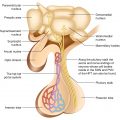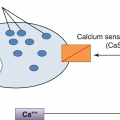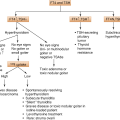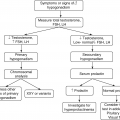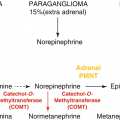div class=”ChapterContextInformation”>
1. Introduction to Endocrinology
1.1 Hormones Action
Hormones are signaling molecules that traffic information from one cell to another, typically through a soluble medium like the extracellular fluid.
Classic endocrine glands include organs like the pituitary gland, thyroid gland, parathyroid glands, pancreatic islets, adrenal glands, ovaries, and testes. It is now clear that hormones can be produced from nontraditional endocrine organs and play critical roles in the regulation of physiological homeostasis. Examples of the latter include the heart (natriuretic peptides), kidney (erythropoietin and renin), adipose tissue (leptin and adiponectin), and gut (cholecystokinin and incretins).
Once in the circulation, hormones bind to receptors on target tissues to elicit their biological effects. Hormones produced in one tissue may promote activity in a target tissue at some distance from the point of secretion (endocrine effects). In this case, the hormone travels through the bloodstream, often bound to a plasma protein, to access the target tissue.
In addition, hormones may act locally following secretion, either on a neighboring non-hormone-producing cell (paracrine effect), on the secretory cell itself (autocrine effect), or without actually being released from the secretory cell (intracrine effect).
1.2 The Chemical Composition of Hormones
Hormones vary widely in terms of their chemical composition: proteins (e.g., adrenocorticotropic hormone (ACTH)), peptide hormones (e.g., growth hormone (GH), parathyroid hormone (PTH), insulin, posterior pituitary hormones), glycoproteins hormones (e.g., follicle-stimulating hormone (FSH), luteinizing hormone (LH), thyroid stimulating hormone (TSH), β-human chorionic gonadotropin (hCG)), monoamines (e.g., norepinephrine), amino acid derivates (e.g., thyroid hormones), steroid hormones (e.g., cortisol, aldosterone, dehydroepiandrosterone (DHEA), estradiol, progesterone, testosterone), lipids (e.g., prostaglandins) and signal through a variety of general (e.g., nuclear vs. cell surface) and specific (e.g., tyrosine kinase vs. phosphoinositide turnover) mechanisms in target cells. In general, protein, peptide, monoamines, and lipophilic hormones tend to exert their effect primarily through protein receptors at the cell membrane (G-protein-coupled receptors and the enzyme-linked receptors), while steroids, thyroid hormone, and vitamin D tend to operate binding to receptors found in the cytoplasmic or nuclear compartments.
1.3 Regulation of Hormone Levels
Hormone levels can be modulated through regulatory factors affecting several steps. However, the bulk of the acute “fine tuning” of hormone levels occurs at the level of hormone secretion and synthesis. Many, if not most, hormone levels are controlled either directly or indirectly by the biologic activity that they serve to control. For example, PTH secretion, which responds to low extracellular calcium levels, mobilizes calcium out of bone which, in turn, signals back to the parathyroid gland to turn off additional PTH secretion. This negative feedback loop is a hallmark of endocrine regulation. The end-product or negative regulator can either be an inorganic ion or a metabolite (e.g., calcium for PTH) or a hormonal product in the endocrine cascade (e.g., thyroid hormone for TSH, IGF-1 for GH, cortisol for ACTH), since many hormones are linked to the hypothalamus-pituitary (HP)-axis. The hypothalamus modulates hypophysis function and consequently, hormones that are produced in the pituitary gland (ACTH, TSH, FSH, LH) increase the production of hormones in peripheral glands (cortisol, T3 and T4, testosterone/estradiol, respectively). In turn, production of HP hormones is subject to negative regulation by peripheral hormones in classic feedback (FB) loops.
Long FB refers to the hormone that was released from the peripheral endocrine glands inhibiting pituitary and/or hypothalamic hormone secretion (e.g., IGF-1 inhibits GHRH and GH, cortisol inhibits ACTH and CRH; see Fig. 1.1).
Short FB refers to a pituitary hormone providing negative feedback to the hypothalamus, inhibiting the secretion of the releasing hormone (e.g., GHRH is inhibited by GH, CRH is inhibited by ACTH; see Fig. 1.1).
Ultrashort FB refers to a hypothalamic hormone that inhibits its own secretion (e.g., GHRH, CRH).
Stay updated, free articles. Join our Telegram channel

Full access? Get Clinical Tree


